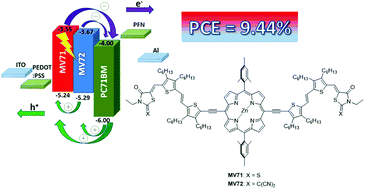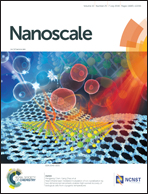Panchromatic ternary organic solar cells with 9.44% efficiency incorporating porphyrin-based donors
Abstract
In an effort to improve the short-circuit current and fill factor, organic solar cells have been developed with ternary blending in a single bulk heterojunction active layer. We report here several all small molecule organic solar cells based on ternary bulk heterojunction active layers. These layers consist of two small molecule porphyrin donors (MV71 and MV72), which have the same backbone but different end-capping acceptor units, and PC71BM as the acceptor. The organic solar cells showed overall power conversion efficiencies of 3.21% and 4.03% for the as-cast MV71:PC71BM and MV72:PC71BM binary active layers, respectively. However, the power conversion efficiency of the ternary active layer, i.e., MV71:MV72:PC71BM (0.2 : 0.8 : 2), was 6.72% and this is higher than the two binary active layer counterparts. The enhancement in the PCE of the ternary active layer is mainly related to the improvement in both the short-circuit current and fill factor and is related to the synergistic effect of the good miscibility of the two donors and improved hole transportation due to the slightly deeper highest occupied molecular orbital energy level of MV72 than MV71. The PCE was further improved to 9.44% with an enhanced short-circuit current and fill factor when the ternary active layer was subjected to solvent vapour annealing for 40 seconds. The ternary organic solar cells showed higher values of the incident photon to current conversion efficiency across the entire wavelength region when compared to the binary counterparts. The same donor backbone facilitates miscibility at the molecular level and the different HOMO and LUMO energy levels of the donors enable charge transport in the devices based on the ternary active layers. The increase in the power conversion efficiency after SVA treatment may be attributed to the migration of MV71 from the mixed region to the donor–acceptor (D–A) interfaces, which in turn affects the charge transfer and recombination processes and is confirmed by the impedance spectroscopy and dark current–voltage measurements.



 Please wait while we load your content...
Please wait while we load your content...